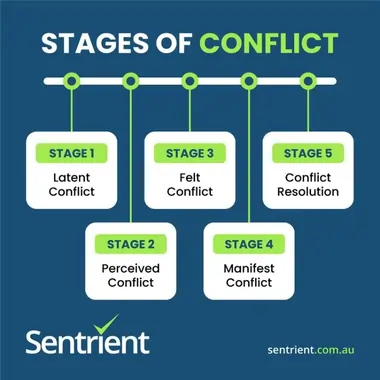In today’s dynamic and diverse workplace environments, conflicts are inevitable in human interaction. From differences in opinions to clashes of personalities, conflicts can arise for various reasons. However, the key lies in how conflicts are managed and resolved. Effective conflict resolution is crucial for maintaining a harmonious work atmosphere and fostering productive relationships among team members. In this blog post, we will delve into the five stages of conflict and explore workplace conflict resolution strategies that can lead to better understanding, cooperation, and overall success.

Stage 1: Latent Conflict
At the heart of every conflict lies a latent stage, characterised by underlying issues that have yet to surface. These can include differences in values, communication breakdowns, or competing goals. Recognising latent conflicts early on is essential for preventing them from escalating into more serious disputes. By fostering open communication and encouraging employees to voice their concerns, organisations can address latent conflicts before they intensify.
Stage 2: Perceived Conflict
Perceived conflicts occur when individuals become aware of the issues and interpret them as potential threats or challenges. This stage is marked by increased tension and emotional responses as individuals take sides and form opinions. It is crucial to encourage active listening and empathetic understanding during this stage to ensure that perceptions are accurate and that misinterpretations are minimised.
Stage 3: Felt Conflict
As the conflict intensifies, emotions run high, and individuals experience the conflict more personally. Felt conflict is where frustration, anger, and resentment may surface. It is essential to create a safe space where employees can express their emotions without fear of judgment. By acknowledging these feelings and addressing them constructively, organisations can prevent conflicts from spiralling out of control.
Stage 4: Manifest Conflict
Manifest conflict is the point at which the conflict becomes visible to others. This stage is characterised by overt actions such as arguments, disagreements, or avoidance. Left unchecked, manifest conflicts can lead to a toxic work environment, decreased productivity, and strained relationships. Organisations should provide conflict resolution training and mediating resources to address this stage effectively, helping parties find common ground and collaborate on solutions.
Stage 5: Conflict Resolution
The final stage of conflict is its resolution. This stage involves finding mutually acceptable solutions to the issues at hand. Effective conflict resolution requires clear communication, active listening, and a willingness to compromise. Encouraging parties to collaborate on finding win-win solutions can improve relationships, increase trust, and strengthen the team’s unity.
Workplace Conflict Resolution Strategies
Now that we’ve explored the stages of the conflict, let’s delve into effective workplace conflict resolution strategies:
- Communication: Open and honest communication is the cornerstone of conflict resolution. Encourage individuals to express their perspectives and concerns while actively listening to others. This fosters understanding and helps identify common ground.
- Mediation: A neutral third party can often facilitate discussions and guide parties towards resolution. Mediators can provide an objective perspective and help bridge gaps between conflicting parties.
- Collaboration: Encourage those involved in the conflict to work together to find solutions. Collaboration promotes a sense of ownership and commitment to the resolution process.
- Empathy: Understanding the emotions and viewpoints of others is vital. Empathy creates a supportive environment where individuals feel heard and valued.
- Negotiation: Finding a middle ground through negotiation allows parties to reach compromises that satisfy their needs and interests.
Conclusion
Conflicts are bound to arise in a diverse and ever-evolving workplace. However, by understanding the five stages of conflict and implementing effective conflict resolution strategies, organisations can transform conflicts into opportunities for growth, collaboration, and improved relationships. Prioritising open communication, empathy, and mutual understanding can pave the way for a more harmonious and productive work environment, benefitting both employees and the organisation’s overall success.





